steering FIAT 500L 2019 Owner handbook (in English)
[x] Cancel search | Manufacturer: FIAT, Model Year: 2019, Model line: 500L, Model: FIAT 500L 2019Pages: 248, PDF Size: 5.74 MB
Page 30 of 248

WINDSCREEN
WIPER/REAR
WINDOW WIPER
WINDSCREEN WIPER /
WASHER
6) 7)
This operates only with the ignition key
turned to MAR.
Ring A fig. 31 has five different
positions:
windscreen wiper off
constant flick with 10 second
periods
“faster” flick (speed related)
LOcontinuous slow operation
HIcontinuous fast operation
MIST functionMove the stalk upwards (unstable
position) to activate the MIST
function: operation is limited to the
time for which the stalk is held in this
position. When released, the stalk
will return to its default position and the
windscreen wiper will be stopped.
This function is useful to remove small
deposits of dust from the windscreen,
or morning dew.
“Smart washing” function
Pull the stalk towards the steering
wheel (unstable position) to operate the
windscreen washer. When the stalk is
held pulled for longer than half a
second, the windscreen wiper is moved
with active control.
The wipers flick three times when the
stalk is released, after which, if the
control is in position
, the washing
cycle is concluded by one last flick after
a pause of approximately 6 seconds.
With the ring inLOorHIposition,
the smart washing function is not
carried out.
Raising the blades ("Service
position" function)
This function makes it possible to
replace the blades or protect them in
conditions of ice and/or snow.Function activation
turn the ring A to position(wiper
stopped);
turn the ignition key to the STOP
position;
after having turned the ignition key
to the STOP position, within two
minutes move the lever to the MIST
within two minutes for at least half a
second to activate the wiper for part
of a flick. This operation can be
repeated up to three times, in order to
move the blade to the most suitable
position for replacement;
turn the ignition key to the MAR
position to move the blades back
down.
The function will be deactivated when
the engine is started again, in case of a
wiping request or with the car moving
(speed above 5 km/h).
IMPORTANT Place the blades back in
contact with the windscreen before
activating the windscreen wiper again
and/or turning the ignition key to
MAR-ON.
IMPORTANT Before activating the
function, make sure, when starting the
engine, that the windscreen is free of
snow or ice.
31F0Y0608C
28
KNOWING YOUR CAR
Page 41 of 248

30)In the event of an accident or sharp
braking, any object placed on the curtain
may be projected backwards in the
passenger compartment, and risk to hurt
the occupants.
31)Abrupt braking or occasional impacts
may cause sudden movements of the load
with consequent situations of hazard for
the driver and passengers: before setting
off, secure the load tightly using the hooks
provided. For securing use cables, ropes
or belts strong enough to hold the items to
be secured.
WARNING
13)Before tilting the seat backrest fully,
remove any objects laid on it.
14)The dimensions of the platform permit
a maximum capacity of distributed weight
of 70 kg (in position 1) or 40 kg (in position
2): do not load objects with a higher
weight.
15)To avoid damaging the blind, do not
place heavy objects on it.
DUALDRIVE
ELECTRIC POWER
STEERING
(for versions/markets, where provided)
This only operates with the ignition
key turned to MAR and engine running.
Electric power steering allows the
force required at the steering wheel to
be adapted to the driving conditions.
IMPORTANT When turning the ignition
key quickly, full power steering
functionality can be achieved after a
few seconds.
IMPORTANT During parking
manoeuvres requiring a lot of steering,
the steering may become harder; this is
normal and is due to the intervention
of the system to protect the electric
steering motor from overheating. No
repair intervention is needed in this
case. When the car is used again, the
power steering will work normally again.IMPORTANT The Dualdrive electric
power steering provides an electronic
damping effect when approaching
the end of travel. In some manoeuvring
conditions, the steering wheel may
perform an additional small rotation until
reaching its mechanical stop. This
behaviour is normal and is intended to
prevent excessive impacts with the
mechanical components located inside
the device.
POWER STEERING
ACTIVATION/
DEACTIVATION
32) 33)
To engage/disengage the electric
power steering press button fig. 51.
The LED above the button switches on
to indicate that the system is active.
51F0Y0646C
39
Page 42 of 248
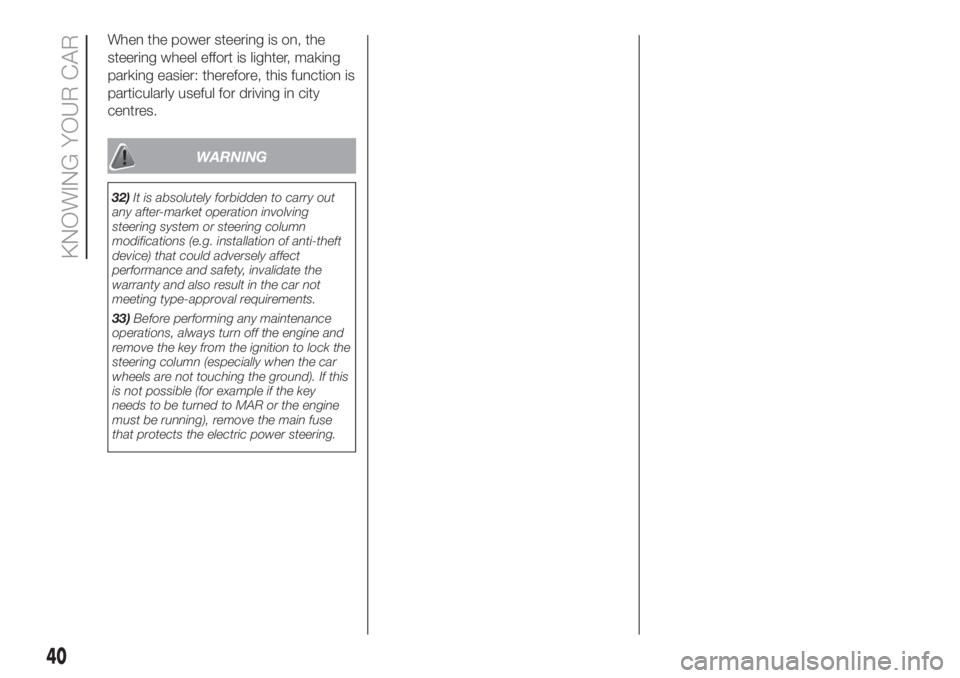
When the power steering is on, the
steering wheel effort is lighter, making
parking easier: therefore, this function is
particularly useful for driving in city
centres.
WARNING
32)It is absolutely forbidden to carry out
any after-market operation involving
steering system or steering column
modifications (e.g. installation of anti-theft
device) that could adversely affect
performance and safety, invalidate the
warranty and also result in the car not
meeting type-approval requirements.
33)Before performing any maintenance
operations, always turn off the engine and
remove the key from the ignition to lock the
steering column (especially when the car
wheels are not touching the ground). If this
is not possible (for example if the key
needs to be turned to MAR or the engine
must be running), remove the main fuse
that protects the electric power steering.
40
KNOWING YOUR CAR
Page 46 of 248
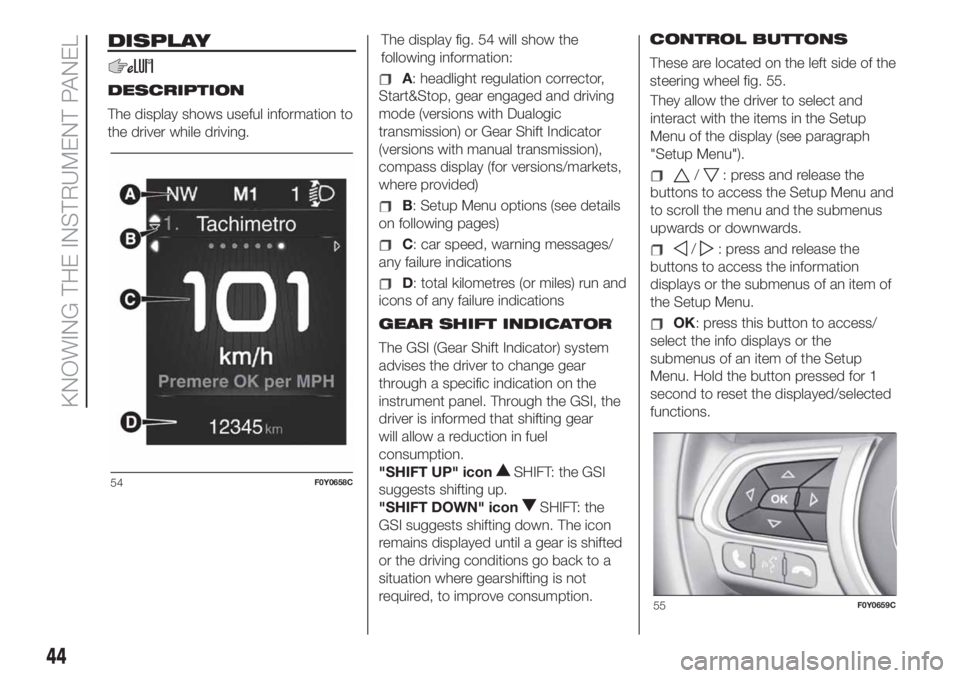
DISPLAY
DESCRIPTION
The display shows useful information to
the driver while driving.The display fig. 54 will show the
following information:A: headlight regulation corrector,
Start&Stop, gear engaged and driving
mode (versions with Dualogic
transmission) or Gear Shift Indicator
(versions with manual transmission),
compass display (for versions/markets,
where provided)
B: Setup Menu options (see details
on following pages)
C: car speed, warning messages/
any failure indications
D: total kilometres (or miles) run and
icons of any failure indications
GEAR SHIFT INDICATOR
The GSI (Gear Shift Indicator) system
advises the driver to change gear
through a specific indication on the
instrument panel. Through the GSI, the
driver is informed that shifting gear
will allow a reduction in fuel
consumption.
"SHIFT UP" icon
SHIFT: the GSI
suggests shifting up.
"SHIFT DOWN" icon
SHIFT: the
GSI suggests shifting down. The icon
remains displayed until a gear is shifted
or the driving conditions go back to a
situation where gearshifting is not
required, to improve consumption.CONTROL BUTTONS
These are located on the left side of the
steering wheel fig. 55.
They allow the driver to select and
interact with the items in the Setup
Menu of the display (see paragraph
"Setup Menu").
/: press and release the
buttons to access the Setup Menu and
to scroll the menu and the submenus
upwards or downwards.
/: press and release the
buttons to access the information
displays or the submenus of an item of
the Setup Menu.
OK: press this button to access/
select the info displays or the
submenus of an item of the Setup
Menu. Hold the button pressed for 1
second to reset the displayed/selected
functions.
54F0Y0658C
55F0Y0659C
44
KNOWING THE INSTRUMENT PANEL
Page 47 of 248
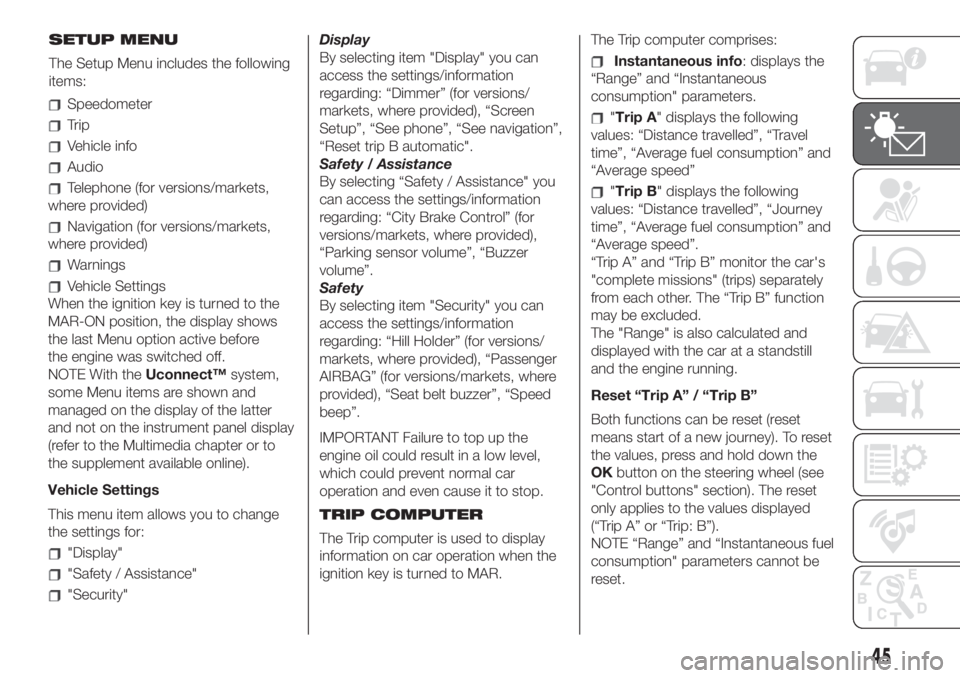
Speedometer
Trip
Vehicle info
Audio
Telephone (for versions/markets,
where provided)
Navigation (for versions/markets,
where provided)
Warnings
Vehicle Settings
When the ignition key is turned to the
MAR-ON position, the display shows
the last Menu option active before
the engine was switched off.
NOTE With theUconnect™system,
some Menu items are shown and
managed on the display of the latter
and not on the instrument panel display
(refer to the Multimedia chapter or to
the supplement available online).
Vehicle Settings
This menu item allows you to change
the settings for:
"Display"
"Safety / Assistance"
"Security"Display
By selecting item "Display" you can
access the settings/information
regarding: “Dimmer” (for versions/
markets, where provided), “Screen
Setup”, “See phone”, “See navigation”,
“Reset trip B automatic".
Safety / Assistance
By selecting “Safety / Assistance" you
can access the settings/information
regarding: “City Brake Control” (for
versions/markets, where provided),
“Parking sensor volume”, “Buzzer
volume”.
Safety
By selecting item "Security" you can
access the settings/information
regarding: “Hill Holder” (for versions/
markets, where provided), “Passenger
AIRBAG” (for versions/markets, where
provided), “Seat belt buzzer”, “Speed
beep”.
IMPORTANT Failure to top up the
engine oil could result in a low level,
which could prevent normal car
operation and even cause it to stop.
TRIP COMPUTER
The Trip computer is used to display
information on car operation when the
ignition key is turned to MAR.The Trip computer comprises:
Instantaneous info: displays the
“Range” and “Instantaneous
consumption" parameters.
"Trip A" displays the following
values: “Distance travelled”, “Travel
time”, “Average fuel consumption” and
“Average speed”
"Trip B" displays the following
values: “Distance travelled”, “Journey
time”, “Average fuel consumption” and
“Average speed”.
“Trip A” and “Trip B” monitor the car's
"complete missions" (trips) separately
from each other. The “Trip B” function
may be excluded.
The "Range" is also calculated and
displayed with the car at a standstill
and the engine running.
Reset “Trip A” / “Trip B”
Both functions can be reset (reset
means start of a new journey). To reset
the values, press and hold down the
OKbutton on the steering wheel (see
"Control buttons" section). The reset
only applies to the values displayed
(“Trip A” or “Trip: B”).
NOTE “Range” and “Instantaneous fuel
consumption" parameters cannot be
reset.
45
SETUP MENU
The Setup Menu includes the following
items:
Page 52 of 248
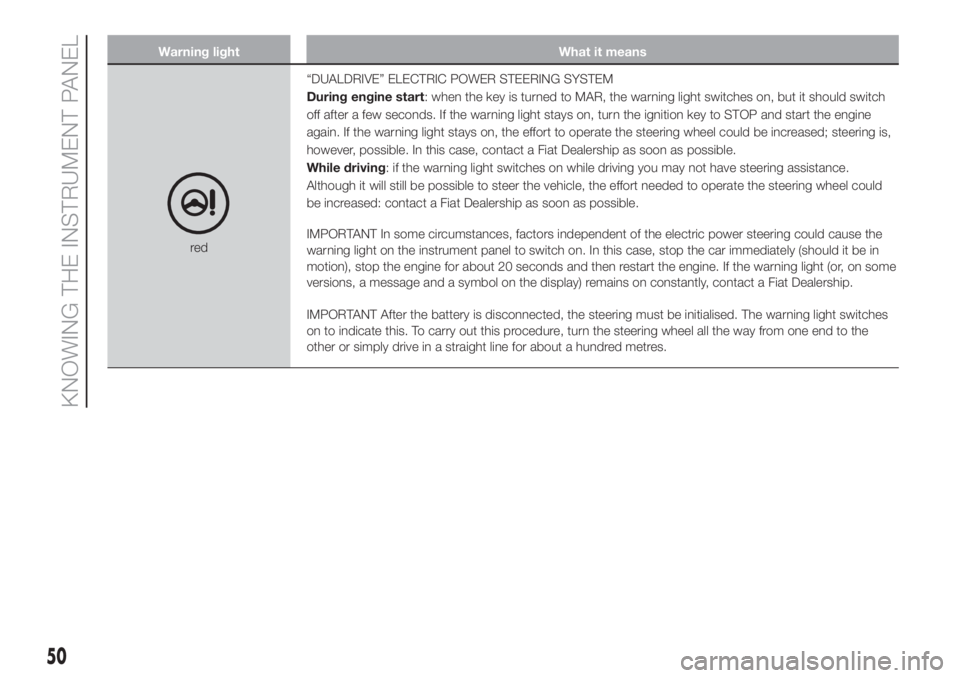
Warning light What it means
red“DUALDRIVE” ELECTRIC POWER STEERING SYSTEM
During engine start: when the key is turned to MAR, the warning light switches on, but it should switch
off after a few seconds. If the warning light stays on, turn the ignition key to STOP and start the engine
again. If the warning light stays on, the effort to operate the steering wheel could be increased; steering is,
however, possible. In this case, contact a Fiat Dealership as soon as possible.
While driving: if the warning light switches on while driving you may not have steering assistance.
Although it will still be possible to steer the vehicle, the effort needed to operate the steering wheel could
be increased: contact a Fiat Dealership as soon as possible.
IMPORTANT In some circumstances, factors independent of the electric power steering could cause the
warning light on the instrument panel to switch on. In this case, stop the car immediately (should it be in
motion), stop the engine for about 20 seconds and then restart the engine. If the warning light (or, on some
versions, a message and a symbol on the display) remains on constantly, contact a Fiat Dealership.
IMPORTANT After the battery is disconnected, the steering must be initialised. The warning light switches
on to indicate this. To carry out this procedure, turn the steering wheel all the way from one end to the
other or simply drive in a straight line for about a hundred metres.
50
KNOWING THE INSTRUMENT PANEL
Page 53 of 248
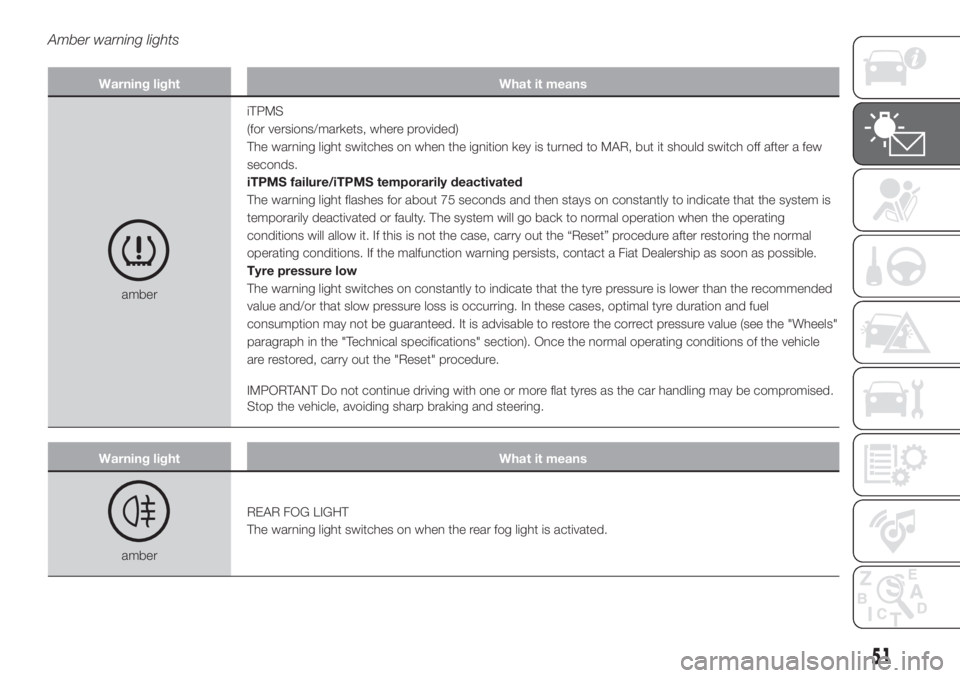
Amber warning lights
Warning light What it means
amberiTPMS
(for versions/markets, where provided)
The warning light switches on when the ignition key is turned to MAR, but it should switch off after a few
seconds.
iTPMS failure/iTPMS temporarily deactivated
The warning light flashes for about 75 seconds and then stays on constantly to indicate that the system is
temporarily deactivated or faulty. The system will go back to normal operation when the operating
conditions will allow it. If this is not the case, carry out the “Reset” procedure after restoring the normal
operating conditions. If the malfunction warning persists, contact a Fiat Dealership as soon as possible.
Tyre pressure low
The warning light switches on constantly to indicate that the tyre pressure is lower than the recommended
value and/or that slow pressure loss is occurring. In these cases, optimal tyre duration and fuel
consumption may not be guaranteed. It is advisable to restore the correct pressure value (see the "Wheels"
paragraph in the "Technical specifications" section). Once the normal operating conditions of the vehicle
are restored, carry out the "Reset" procedure.
IMPORTANT Do not continue driving with one or more flat tyres as the car handling may be compromised.
Stop the vehicle, avoiding sharp braking and steering.
Warning light What it means
amberREAR FOG LIGHT
The warning light switches on when the rear fog light is activated.
51
Page 73 of 248
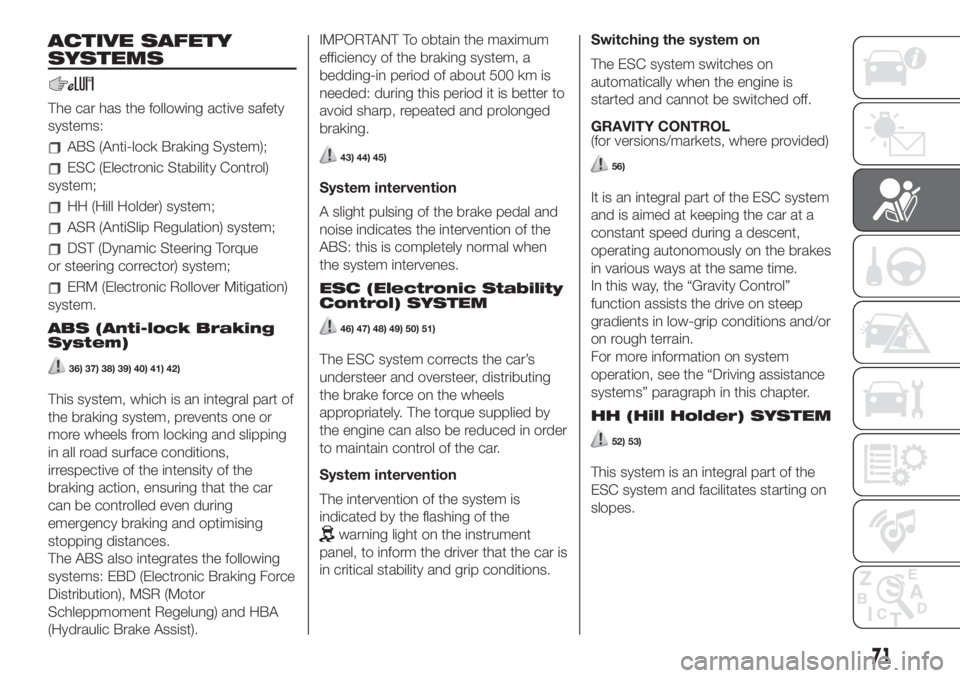
ACTIVE SAFETY
SYSTEMS
The car has the following active safety
systems:
ABS (Anti-lock Braking System);
ESC (Electronic Stability Control)
system;
HH (Hill Holder) system;
ASR (AntiSlip Regulation) system;
DST (Dynamic Steering Torque
or steering corrector) system;
ERM (Electronic Rollover Mitigation)
system.
ABS (Anti-lock Braking
System)
36) 37) 38) 39) 40) 41) 42)
This system, which is an integral part of
the braking system, prevents one or
more wheels from locking and slipping
in all road surface conditions,
irrespective of the intensity of the
braking action, ensuring that the car
can be controlled even during
emergency braking and optimising
stopping distances.
The ABS also integrates the following
systems: EBD (Electronic Braking Force
Distribution), MSR (Motor
Schleppmoment Regelung) and HBA
(Hydraulic Brake Assist).IMPORTANT To obtain the maximum
efficiency of the braking system, a
bedding-in period of about 500 km is
needed: during this period it is better to
avoid sharp, repeated and prolonged
braking.
43) 44) 45)
System intervention
A slight pulsing of the brake pedal and
noise indicates the intervention of the
ABS: this is completely normal when
the system intervenes.
ESC (Electronic Stability
Control) SYSTEM
46) 47) 48) 49) 50) 51)
The ESC system corrects the car’s
understeer and oversteer, distributing
the brake force on the wheels
appropriately. The torque supplied by
the engine can also be reduced in order
to maintain control of the car.
System intervention
The intervention of the system is
indicated by the flashing of the
warning light on the instrument
panel, to inform the driver that the car is
in critical stability and grip conditions.Switching the system on
The ESC system switches on
automatically when the engine is
started and cannot be switched off.
GRAVITY CONTROL
(for versions/markets, where provided)
56)
It is an integral part of the ESC system
and is aimed at keeping the car at a
constant speed during a descent,
operating autonomously on the brakes
in various ways at the same time.
In this way, the “Gravity Control”
function assists the drive on steep
gradients in low-grip conditions and/or
on rough terrain.
For more information on system
operation, see the “Driving assistance
systems” paragraph in this chapter.
HH (Hill Holder) SYSTEM
52) 53)
This system is an integral part of the
ESC system and facilitates starting on
slopes.
71
Page 74 of 248
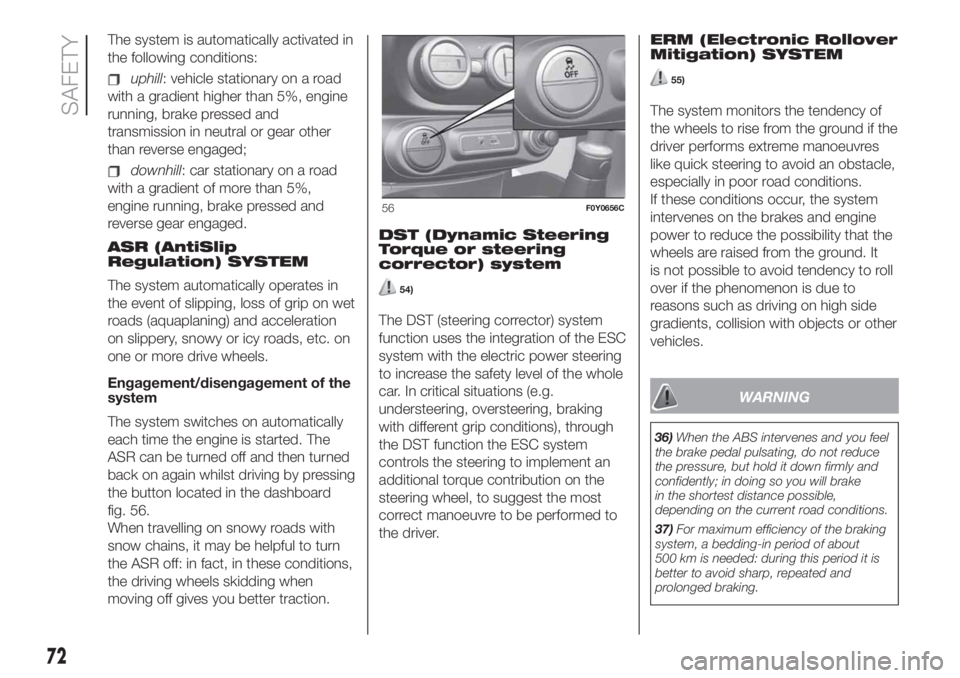
The system is automatically activated in
the following conditions:
uphill: vehicle stationary on a road
with a gradient higher than 5%, engine
running, brake pressed and
transmission in neutral or gear other
than reverse engaged;
downhill: car stationary on a road
with a gradient of more than 5%,
engine running, brake pressed and
reverse gear engaged.
ASR (AntiSlip
Regulation) SYSTEM
The system automatically operates in
the event of slipping, loss of grip on wet
roads (aquaplaning) and acceleration
on slippery, snowy or icy roads, etc. on
one or more drive wheels.
Engagement/disengagement of the
system
The system switches on automatically
each time the engine is started. The
ASR can be turned off and then turned
back on again whilst driving by pressing
the button located in the dashboard
fig. 56.
When travelling on snowy roads with
snow chains, it may be helpful to turn
the ASR off: in fact, in these conditions,
the driving wheels skidding when
moving off gives you better traction.DST (Dynamic Steering
Torque or steering
corrector) system
54)
The DST (steering corrector) system
function uses the integration of the ESC
system with the electric power steering
to increase the safety level of the whole
car. In critical situations (e.g.
understeering, oversteering, braking
with different grip conditions), through
the DST function the ESC system
controls the steering to implement an
additional torque contribution on the
steering wheel, to suggest the most
correct manoeuvre to be performed to
the driver.ERM (Electronic Rollover
Mitigation) SYSTEM
55)
The system monitors the tendency of
the wheels to rise from the ground if the
driver performs extreme manoeuvres
like quick steering to avoid an obstacle,
especially in poor road conditions.
If these conditions occur, the system
intervenes on the brakes and engine
power to reduce the possibility that the
wheels are raised from the ground. It
is not possible to avoid tendency to roll
over if the phenomenon is due to
reasons such as driving on high side
gradients, collision with objects or other
vehicles.
WARNING
36)When the ABS intervenes and you feel
the brake pedal pulsating, do not reduce
the pressure, but hold it down firmly and
confidently; in doing so you will brake
in the shortest distance possible,
depending on the current road conditions.
37)For maximum efficiency of the braking
system, a bedding-in period of about
500 km is needed: during this period it is
better to avoid sharp, repeated and
prolonged braking.
56F0Y0656C
72
SAFETY
Page 78 of 248

The "Reset" procedure must be carried
out:
each time tyre pressure is modified;
when even only one tyre is changed;
when tyres are rotated/inverted;
when the space-saver wheel is
fitted.
Before carrying out the “Reset”
procedure, inflate the tyres to the rated
pressure values specified in the inflation
pressure table (see "Wheels" paragraph
in the "Technical specifications"
chapter).
If the “Reset” procedure is not carried
out, in all above cases, the
warning
light may give false indications on
one or more tyres.
To carry out the “Reset” procedure,
with the car stopped and the ignition
device at MAR, use the Setup Menu on
the display as follows:
go to "Vehicle info" and then to
"Reset tyres";
hold the "OK" button the steering
wheel pressed (see figure) more longer
than 2 seconds;
the display will show the procedure
progress until the "Reset" is completed.At the end of the “Reset” procedure the
display will show the dedicated
message, indicating that the self-
learning has been started. If the
self-learning procedure of the iTPMS
system has was not performed
correctly on the display, no message
will be shown.
Operating conditions
The system is active for speeds above
15 km/h.
In a few situations such as sporty
driving, particular conditions of the road
surface (e.g. ice, snow, unsurfaced
roads) the warning may be delayed or
partial in detecting the contemporary
deflation of more than one tyre.Under special conditions (e.g. car
loaded asymmetrically on one side,
towing a trailer, damaged or worn tyre,
fitting the space-saver wheel, use of the
"Fix&Go Automatic" kit, fitting snow
chains, fitting different tyres on the
axles) the system may give false
indications or be temporarily
deactivated.
If the system is temporarily deactivated
the
warning light flashes for about
75 seconds and then is continuously
on; at the same time, the display shows
a dedicated message and the symbols
"– –" will appear next to the shape of
the car next to each tyre.
This warning is displayed also after the
engine has been switched off and
then on again if the correct operating
conditions are not restored.
In the case of abnormal signals, it is
recommended to perform the “Reset”
procedure. If the indications appear
again after a successful “Reset”, check
that the tyres used on all four wheels
are the same and that the tyres are not
damaged. As soon as possible, refit
the standard tyre instead of the
space-saver spare, remove the snow
chains (if possible), check correct
load distribution and repeat the “Reset”
procedure by driving on a clean,
tarmacked road. If the indications
persist, contact a Fiat Dealership.61F0Y0659C
76
SAFETY